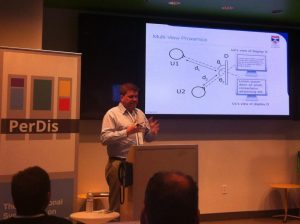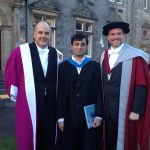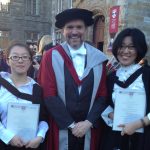Rapid Prototyping with .net Gadgeteer in St Andrews, July 24, 2013 from 9:30 AM to 5:00 PMWe are pleased to host a hardware workshop on “Rapid Prototyping with .Net Gadgeteer“. Tilman and Thomas will give an introduction to the .NET Gadgeteer Platform and show some prototypes. Over the first part of the course they show how to build a digital camera, followed by group projects where they ask participants to come up with ideas that are relevant to their fields of research/studies.
Tilman and Thomas are two researchers from the University of Stuttgart and they are interested in the design space as well as limitations of building smart artifacts using .NET Gadgeteer. The workshop is kindly supported by Microsoft Research in Cambridge which is why there is no cost for hosts or participants. .NET Gadgeteer was developed for Open Source usage in Cambridge.
We thanks the SICSA MMI theme for their support in bringing this workshop here along with it’s sister workshop in Glasgow. If you are a SICSA student you can signup to this event here.
News
Information retrieval document analysis tasks, such as those conducted by search engines are ideal Big Data tasks, as they are often embarrassingly parallelisable using techniques such as MapReduce. However, while a large portion of the document sets such as the Web are static in nature, social media sources such as Twitter and Facebook generate document streams comprised of hundreds of millions of posts each day. The easy availability, high volume and tendency of such streams to reflect real-world events make them ideal sources of information to drive applications such as event detection or real-time search. However, the scale of these data streams mean that distributed parallel processing is needed, while traditional distributed processing paradigms such as MapReduce are unsuited to streaming data due to their batch-orientated nature. In this presentation, we will provide a brief overview of Big Data analysis within IR, before moving onto the challenges that real-time streaming data streams pose, discussing the new generation of distributed steam processing platforms currently under development and illustrating how one specific use-case, namely real-time search can be accomplished using one such platform.
This week Aaron is attending the Second International Symposium on Pervasive Displays at the Google campus in Mountain View, California. He is attending to present a paper co-authored with Jakub Dostal and Per Ola Kristensson in SACHI, along with being a session chair on the second day of the conference. The paper is titled.
Dostal, J., Kristensson, P.O. and Quigley, A. 2013. Multi-view proxemics: distance and position sensitive interaction. In Proceedings of the 2nd International Symposium on Pervasive Displays (PerDis 2013). ACM Press: forthcoming.

Aaron presenting at International Symposium on Pervasive Displays (photo courtesy Albrecht Schmidt)
The paper presents SACHI research from these three authors at the intersection of proxemic interaction and multi-view display technologies. This work relies on underlying technologies to determine the viewers, their distance and angle to the display. Knowledge of these factors allows us to design interactive systems which exploits it for novel forms of interaction. We explore this in two studies that are based on two real-world scenarios of a departure board and a video player (with subtitles). Our results show that multi-view proxemic systems are accurate and that users find them useful and would use them if they were available.
This year from across SICSA we have at least 16 notes, papers and TOCHI papers being presented at CHI in Paris along with numerous WIPs, workshop papers, SIGs etc. On April 23rd we hosted 35+ people from across SICSA for a Pre-CHI day which allowed all presenters a final dry run of their talks with feedback. This was also an opportunity to inform others across SICSA about their work while allowing everyone an opportunity to snap-shot HCI research in Scotland.
Pre-CHI Day – April 23, 2013: 10am – 4:30pm – Location: Medical and Biological Sciences Building, Seminar Room 1
9:30 – 10:00 Coffee/Tea
10:00 – 10:25 Memorability of Pre-designed and User-defined Gesture Sets M. Nacenta, Y. Kamber, Y. Qiang, P.O. Kristensson (Univ. of St Andrews, UK) Paper
10:25 – 10:50 Supporting Personal Narrative for Children with Complex Communication Needs R. Black (Univ. of Dundee, UK), A. Waller (Univ. of Dundee, UK) R. Turner (Data2Text, UK), E. Reiter (Univ. of Aberdeen, UK) TOCHI paper
10:50 – 11:05 Coffee Break
11:05 – 11:30 Use of an Agile Bridge in the Development of Assistive Technology S. Prior (Univ. of Abertay Dundee, UK). A. Waller (Univ. of Dundee, UK) T. Kroll (Univ. of Dundee, UK), R. Black (Univ. of Dundee, UK) Paper
11:30 – 11:45 Multiple Notification Modalities and Older Users D. Warnock, S. Brewster, M. McGee-Lennon (Univ. of Glasgow, UK) Note
11:45 – 11:55 Visual Focus-Aware Applications and Services in Multi-Display Environments J. Dostal, P.O. Kristensson, A. Quigley (Univ. of St Andrews) Workshop paper (Workshop on Gaze Interaction in the Post-WIMP)
12:00 – 1:00 Lunch Break & Poster Presentations
1:00 – 1:25 ‘Digital Motherhood’: How does technology help new mothers? L. Gibson and V. Hanson (Univ. of Dundee, UK) Paper
1:25 – 1:40 Combining Touch and Gaze for Distant Selection in a Tabletop Setting M. Mauderer (Univ. of St Andrews), F. Daiber (German Research Centre for Artificial Intelligence – DFKI), A. Krüger (DFKI) Workshop paper (Workshop on Gaze Interaction in the Post-WIMP)
1:40 – 2:05 Focused and Casual Interactions: Allowing Users to Vary Their Level of Engagement H. Pohl (Univ. of Hanover, DE) and R. Murray-Smith (Univ. of Glasgow, UK) Paper
2:05 – 2:20 Seizure Frequency Analysis Mobile Application: The Participatory Design of an Interface with and for Caregivers Heather R. Ellis (Univ. of Dundee) Student Research Competition
2:20 – 2:40 Coffee Break
2:40 – 3:05 Exploring & Designing Tools to Enhance Falls Rehabilitation in the Home S. Uzor and L. Baillie (Glasgow Caledonian Univ., UK) Paper
3:05 – 3:30 Understanding Exergame Users’ Physical Activity, Motivation and Behavior Over Time A. Macvean and J. Robertson (Heriot-Watt Univ., UK) Paper
3:30 – 3:45 Developing Efficient Text Entry Methods for the Sinhalese Language S. Reyal (Univ. of St Andrews), K. Vertanen (Montana Tech), P.O. Kristensson (Univ. of St Andrews) Workshop paper (Grand Challenges in Text Entry)
3:45 – 4:10 The Emotional Wellbeing of Researchers: Considerations for Practice W. Moncur (Univ. of Dundee, UK) Paper
4:10 – 4:30 Closing remarks and (optional) pub outing.
On July 8th, Rónan McAteer from the Watson Solutions Development Software Group in IBM Ireland will give a talk as part of the Big Data Information Visualisation Summer School here in St Andrews. This talk is entitled “Cognitive Computing: Watson’s path from Jeopardy to real-world Big (and dirty) Data.”
While this talk is part of the summer school, we are trying to host it in a venue in central St Andrews during the evening of July 8th so that people from across St Andrews and SICSA can attend if they wish.
The Abstract for Rónan’s talk is below:
Building on the success of the Jeopardy Challenge in 2011, IBM is now preparing Watson for use in commercial applications. At first glance, the original challenge appears to present an open-domain question answering problem. However, moving from the regular, grammatical, well-formed nature of gameshow questions, to the malformed and error-strewn data that exists in the real world, is very much a new and complex challenge for IBM. Unstructured and noisy data in the form of natural language text, coming from sources like instant messaging and recorded conversations, automatically digitised text (OCR), human shorthand notes (replete with their individual sets of prose and typos), must all be processed in a matter of seconds, to find the proverbial ‘needle in the haystack’.
In this talk we’ll take a look at how Watson is rising to meet these new challenges. We’ll go under the hood to take a look at how the system has changed since the days of Jeopardy, using state-of-the-art IBM hardware and software, to significantly reduce the cost while increasing the capability.
SACHI, the St Andrews Computer Human Interaction research group and the Big Data Lab St Andrews are pleased to announce that we will jointly run a SICSA supported “Big Data Information Visualisation” summer school on July 8th-12th 2013. This summer school is concerned with the processing, management and hence presentation of “big data”, in an intelligible form with information visualisation techniques and methods. In this school we take a blended theory and application approach here with hands on work with data, big data systems and information visualisation toolkits.
The first round of applications closes on March 15th, 2013. If there are places remaining, the second round of applications will close on Apr 19th 2013.
More details can be found here.
 This SIG meeting provides a forum for visionaries; researchers and practitioners looking to consider the place and importance of visions within CHI. Can visions, the process of visioning and forming new visions help us refine, advance or develop new research or forms of interaction. And if visions are important to us, then are they part of the regular academic process? If so, should CHI provide venues for publishing new visions?
This SIG meeting provides a forum for visionaries; researchers and practitioners looking to consider the place and importance of visions within CHI. Can visions, the process of visioning and forming new visions help us refine, advance or develop new research or forms of interaction. And if visions are important to us, then are they part of the regular academic process? If so, should CHI provide venues for publishing new visions?
To support the planning for this Special Interest Group meeting we have setup a Wiki called Visions Of Computing. If you would like to contribute contact Aaron Quigley for an account.
Next week Professor Quigley is presenting a seminar in the University of Konstanz, Germany as an invited speaker by Professor Harald Reiterer
Abstract:
The computational and contextual edifice around which we will build our ubicomp user interfaces is complex and constantly changing. This context include physiological, environmental and computational state. In this regard, can we model the physiological differences between people and use the models to adapt and personalize designs, user interfaces and artefacts? Can we model, measure and predict the cost of users altering their gaze in single or multi-display environments? If so, can we personalize interfaces using this knowledge. What about when moving and while the distance between user and screen is varying. Can this be considered a new modality and used to personalize the interfaces along with physiological differences and our current gaze. In this talk we seek to answer some of these questions. We define Ubicomp User Interfaces and introduce an Individual Observer Model of human eyesight, which we use to simulate 3600 biologically valid human eyes. We also report on controlled lab and outdoor experiments with real users. This is to measure both gaze and distance from the screen in an attempt to quantify the cost of attention switching along with the use of distance as a modality. In each case, for distance, gaze or expected eyesight we would like to develop models which can allow us to make predictions about how easy or hard it is to see visual information and visual designs, along with altering the designs to suit individual users based on their current context.
 Today is St Andrews day and a number of current and former SACHI members graduated from the University of St Andrews.
Today is St Andrews day and a number of current and former SACHI members graduated from the University of St Andrews.
Dr Umar Rashid who was supervised by Professor Aaron Quigley and Dr Miguel Nacenta was awarded his PhD for a thesis entitled “Cross-Display Attention Switching in Mobile Interaction with Large Displays”. Dr Per Ola Kristensson was his internal examiner and Dr Adrian Friday from the University of Lancaster was his external examiner. 
Jing Sun and Hong Xue who were supervised by Professor Aaron Quigley graduated with the Degree of M.Sc. Hong was awarded the Medal for M.Sc. in Information Technology and the School of Computer Science Award in Information Technology. Bin Han who was supervised by Dr Per Ola Kristensson graduated with the Degree of M.Sc. Moses Akazue supervised by Dr Miguel Nacenta graduated with the Degree of M.Sc. 
Anne-Marie Mann who is now a PhD student in SACHI graduated with the Degree of M.Sc.
 SACHI along with other colleagues in Computer Science and across St Andrews are organising a SICSA supported “Big Data Information Visualisation” summer school in July of 2013. We are working on developing the program for this summer school bringing together expertise in a number of areas. Over the weeks and months ahead we will be adding to this website as we confirm topics and speakers. We already have a number of colleagues locally dealing with big data who are willing to act as mentors and domain experts during the summer school.
SACHI along with other colleagues in Computer Science and across St Andrews are organising a SICSA supported “Big Data Information Visualisation” summer school in July of 2013. We are working on developing the program for this summer school bringing together expertise in a number of areas. Over the weeks and months ahead we will be adding to this website as we confirm topics and speakers. We already have a number of colleagues locally dealing with big data who are willing to act as mentors and domain experts during the summer school.

